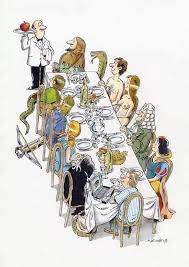This post was inspired by G. Gigerenzer's book, Gut Feelings: The Intelligence of the Unconscious. I'm drawing an analogy that I think informs us about how science works, at least from what I understand from the history of science. It also seems to resonate with the reflections of current alignment researchers, for example, see Richard's post Intuitions about solving hard problems.
Imagine that you ask a professional baseball player, let's call him Tom, how does he catch a fly ball? He takes a moment to respond realizing he's never reflected on this question before and ends up staring at you, not knowing how or what is there exactly to explain. He says he's never thought about it. Now imagine that you ask his baseball coach what's the best way to catch the ball. The coach has a whole theory about it. In fact, he insists that Tom and everyone on the team should follow one specific technique he thinks it's optimal. Tom and the rest of the team go ahead and do what the coach said (because they don't want to get yelled at even though they've been doing fine so far). And lo and behold the team misses the ball more often than before.
What could have gone wrong?
Richard Dawkins, in The Selfish Gene, gives the following explanation:
When a man throws a ball high in the air and catches it again, he
behaves as if he had solved a set of differential equations in predicting
the trajectory of the ball. He may neither know nor care what a
differential equation is, but this does not affect his skill with the ball. At
some subconscious level, something functionally equivalent to the
mathematical calculations is going on.
So here's the analogy I want to argue for: when you do science, by which I mean, when you set up your scientific agenda and organize your research, construct your theoretic apparatus, design experiments, interpret results, and so on, you behave as if you had solved a set of differential equations predicting the trajectory of your research. You may neither know nor care what this process is, but this does not affect your skill with the setup of your project. At some subconscious level, something functionally equivalent to the mathematical calculations is going on. (Be careful, I obviously don't mean the calculations that are explicitly part of solving the problem).
Well, I just paraphrased Dawkins' passage to make a point and that is that what we mean by "gut feelings" or "intuitions" is not magic, but rather a cognitive mechanism. This applies to a variety of tasks from baseball to thinking about agent foundations. It's a cognitive procedure that might even be ultimately explained in mathematical terms about how the brain works.
Up until this point, it looks like I draw this analogy with the practice of science in general in mind. It's worth trying to see what the analogy could suggest for alignment research, granting that it's still at a pre-paradigmatic stage.
My analogy predicts that one or multiple insights about solving the alignment problem will come the way the experienced baseball player hits the ball before following his coach's instructions: as a natural movement in virtue of his gut feelings. And it will be a successful movement. Sure, that requires unpacking, but I think Gigerenzer offers a satisfactory account in his book. [1]
Meanwhile, in the contemporary study of the history of science (especially HPS approaches), we talk about myths in science and then have arguments that debunk them. One of the most famous myths, widespread in popular culture is that an apple hit Newton's head which inspired him to formulate the law of universal gravitation.
While this episode is primarily a cute myth about scientific discovery robustly incorporated into the historiographical package of the hero-scientist ideal, it reveals a truth about how scientists think, or at least, what we have noticed and prima facie believe about how they think. It encapsulates this sense of not being able to explain exactly how you got your insight as a scientist, just like the baseball player is clueless about what makes him catch the ball so perfectly. So, if this myth is meant to be treated as a metaphor then it tells us that the a-ha moment (also known as the "eureka effect") in scientific research, might come when you least expect it; a falling apple might just trigger it.
The scientist might try to rationalize the process in hindsight, trace back the steps in his reasoning and find clever ways to explain how he got to his insight. But it's plausible to believe that there's a whole cognitive mechanism of heuristics and gut feelings that made a product of intuitive reasoning look like the most natural next move.
As far as alignment is concerned, I think some researchers have already ordered and received their apples (okay, perhaps smaller size apples). And if this continues and we're still alive, the one apple that's going to change the flow of the most important century will make its appearance.

- ^
Gigerenzer talks about this in a chapter called "Winning without thinking". He brings up heuristics and especially the "gaze heuristic" and explains how this works in the baseball example. Just in case there's confusion, I'm not conflating insight and intuition; I think that insight is generated through following one's intuitions, i.e., it's a product of intuitive reasoning. So, in that sense, it's plausible to suppose that heuristics contribute to the generation of insights.
